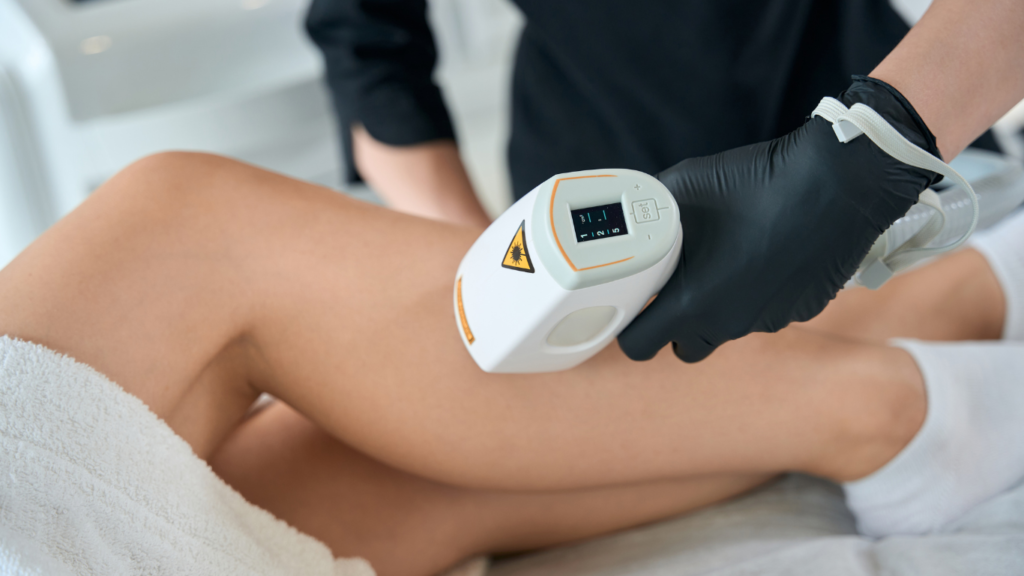If you’ve ever dreamt of ditching razors for laser hair removal, it is a highly effective way to remove hair for extended periods. However, there are seasonal considerations that can affect when you should make your first appointment.
What to Remember About Laser Hair Removal
Laser hair removal utilizes concentrated light which is absorbed by the pigment in your body hair. The heat produced disrupts the hair follicles and inhibits regrowth. It isn’t permanent but it can slow down hair growth significantly. The frequency of repeat sessions is determined by each person’s skin color and type.
It is essential to only get laser hair removal treatment from qualified professionals as the procedure does require individualized approaches. During your initial consultation we will create a hair removal plan based on the outcome you are looking for, your skin type, and hair color.
Why is the Season an Important Consideration for Laser Hair Removal?
There are crucial instructions for laser hair removal aftercare to which you must adhere. These include avoiding sun exposure which can be difficult depending on the season. Direct sunlight can cause laser hair removal side effects like burns and hyperpigmentation which can be challenging to deal with and get rid of.
According to some laser hair removal technicians, it’s possible that the treatments will be less painful during warmer months. The theory is that the skin is more sensitive to heat during the summer months, making the laser more effective and less painful. You can get laser hair removal at any time during the year, but there are several benefits to choosing winter.
The Benefits of Laser Hair Removal in Fall and Winter
Minimal sun exposure. Due to the cooler temperatures, we mostly wear long pants and long sleeve shirts which make it easier to avoid direct sunlight which can damage your skin right after hair removal treatments. The shorter days also offer less sunshine, reducing the chance of exposure.
Fewer outdoor activities. Summer entertainment like swimming and outdoor sports are usually put on hold in winter. The chemicals in swimming pools and extended exposure to harsh sunlight can hinder the recovery process and cause further damage to your skin and follicles.
You’ll be ready for summer. Doing your initial laser hair removal treatments in fall and winter will ensure that your body will be hair free and summer ready by the time June rolls around. This way you can enjoy a summer spent in shorts without worrying about hair removal treatments.
Consistent skin tone. During summer, light skinned individuals are more likely to pick up a fresh tan which can interfere with laser hair removal. So, if you do have a tan wait at least two weeks before starting treatment. Winter is ideal because most natural tans have faded by then.
No need for shaving. To get optimal results from laser hair removal, you should avoid shaving for at least four weeks. This can be difficult in summer if you like to wear shorts and dresses. Winter works best because your body will be covered, and you can skip shaving.
Less sweating. After laser hair removal treatments, sweat can cause irritation and itching. The cool weather in fall and winter reduces how much we sweat. This makes it easier to avoid discomfort and potential infections from bacteria entering the damaged hair follicles.
Laser Hair Removal Aftercare Tips
After laser hair removal treatments, your skin will be extremely sensitive. This means you should take extra care nourishing your skin and avoiding damage. Follow these tips to protect your freshly lasered skin.
1. You should use cool compresses and aloe vera gel to reduce redness and swelling. If irritation persists for more than two days, reach out to your technician.
2. As mentioned above, avoiding sun exposure is vital. Always use SPF 30 or higher and stay out of direct sunlight as much as possible for at least two weeks.
3. Avoid hair removal techniques other than shaving. Waxing, plucking, and depilatory creams can irritate and further damage your hair follicles.
4. Don’t have hot showers or baths for at least two days after treatment. You should also skip the hot tub and sauna during this period. Heating pads also fall into this category.
5. Gently exfoliate the skin between hair removal sessions. This softens skin, accelerates hair follicle shedding, and properly prepares your skin for the next treatment session.
6. Drinking tons of water is the best way to minimize the dryness that can sometimes follow laser hair removal. Staying hydrated can also speed up the healing process.
Pick the Perfect Time for Laser Hair Removal
While many people have laser hair removal treatments year-round, it’s important to understand the effects of the seasons. Choosing the summer months can make it difficult and uncomfortable to avoid the sun, while winter can make it much easier to protect your skin from potential irritation.
